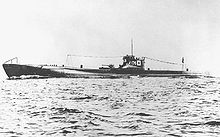USS Corvina (SS-226)
 The USS Corvina at the launch. |
|
| Overview | |
|---|---|
| Keel laying | September 21, 1942 |
| Launch | May 9, 1943 |
| 1. Period of service |
|
| Commissioning | August 6, 1943 |
| Whereabouts | Sunk south of Truk on November 17, 1943 (82 dead) |
| Technical specifications | |
| displacement |
Surface: 1,525 ts. |
| length |
95.33 m |
| width |
8.30 m |
| Draft |
4.65 m |
| Diving depth | 90 m test depth 140 m maximum depth |
| crew |
82 men (1943) |
| drive |
4 × 990 kW General Motors -9- cylinder - Diesel engine |
| speed |
Surface: 20.25 kn. |
| Range |
11,000 nm at 10 kn |
| Armament |
6 × 53.3 cm torpedo tubes in the front |
The USS Corvina (SS-226) was a United States Navy submarine that was used in the Pacific theater of war during World War II and was sunk on its first mission in 1943. The submarine belonged to the Gato class and was completed as the 59th unit of this type. The Corvina , named after the fish Corvina ( belonging to the genus Cynoscion ), was laid on September 21, 1942 at the shipyard of the Electric Boat Corporation in Groton (US state Connecticut ), launched on May 9, 1943 and was finally put into service on August 6, 1943. The first (and last) in command of the submarine was Commander Roderick Shanahan Rooney.
period of service
After completion of the submarine, the crew initially completed test and training drives off the coasts of Rhode Island and Connecticut between August 22 and mid-September 1943 . The Corvina was then detached to Submarine Squadron (Subron) 4 of the US Pacific Fleet stationed in Pearl Harbor . The boat left New London on September 18, 1943 , passed the Panama Canal on September 29, and finally reached Pearl Harbor on October 14, 1943.
From there, the Corvina set out on its first patrol on November 4, 1943. The aim of this mission was to observe the Japanese shipping traffic around the strong Japanese base Truk and in the area of the southern Caroline Islands . The boat was supposed to operate together with the two US submarines Drum and Blackfish during this mission, which took place in the context of the ongoing US offensive against the Gilbert Islands and which was classified as risky . After the Corvina had made a short stopover on November 6, 1943 on the Johnston Atoll and refilled its fuel reserves there, the submarine continued to the sea areas south of Truk. From this point on, the Corvina no longer answered . In mid-March 1944, the US Navy finally admitted that the submarine was believed to have been lost.
Since it was initially completely unclear what could have happened to the submarine - there was also speculation about an accident or contact with a floating sea mine - the Corvina and all of its crew were considered lost for years . It was only after the end of the war in 1945 and after Japanese reports from the US Navy could be evaluated that what had happened to the boat could be reconstructed.
Sinking the Corvina
On the night of 16./17. November 1943, shortly after 11:00 p.m., the Japanese submarine I 176 (under the command of Kaigun-Shōsa Yamaguchi Kazuo) discovered the Corvina, which had surfaced and was marching slowly, about 300 nautical miles south of Truk . The Japanese bridge observers were able to make out the opposing boat from a distance of around eight kilometers on a smooth sea and due to bright moonlight . It is unclear why the crew of the US submarine, which had radar , did not notice the Japanese. Maintenance work may have been carried out on the radar device.
The Japanese submarine first dived and , without being noticed by the crew of the US submarine, crept up to the Corvina in a good firing position over the next two hours . At 1:20 a.m., I 176 , standing on the starboard side of the enemy and from around 2,000 meters away, fired three torpedoes at the Corvina . Almost 25 seconds later, two of the torpedoes hit the US submarine, which then exploded and sank within seconds. Kaigun-Shōsa Yamaguchi let I 176 emerge afterwards and circumnavigated the place of sinking, where oil and debris accumulated on the sea surface. However, he did not find any survivors.
Commander Rooney and all 81 crew members went down with the Corvina .
Note and trivia
The Corvina was the only United States Navy submarine that was lost to an enemy submarine during World War II . In addition, the submarine was the only unit in the history of the US Navy that was baptized with the name Corvina .
Individual evidence
- Jump up ↑ On Eternal Patrol - Loss of USS Corvina (SS-226). Retrieved March 21, 2020 .
- ↑ http://www.navsource.org/archives/08/08226.htm
- ^ IJN Submarine I-176. In: Imperial Submarines. Retrieved March 21, 2020 .
- ^ Heden, Karl E.: Sunken Ships. World War II US Naval Chronology, Including Submarine Losses of the United States, England, Germany, Japan, Italy . Branden Publishing Company. Wellesley (MA) 2006, pp. 90f.
literature
- Bendert, Harald: Submarines in a duel . ES Mittler & Sohn. Hamburg 1996.
- Heden, Karl E .: Sunken Ships. World War II US Naval Chronology, Including Submarine Losses of the United States, England, Germany, Japan, Italy . Branden Publishing Company. Wellesley (MA) 2006.
- Silverstone, Paul H .: The Navy of World War II . Routledge / Taylor & Francis Group. New York (NY) 2008.
- Stille, Marc: Imperial Japanese Navy Submarines of World War II 1941-1945 . Osprey Publishing. New York (NY) 2007.
